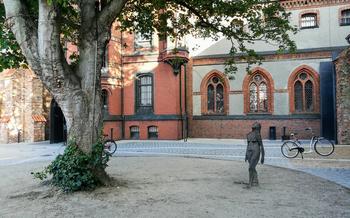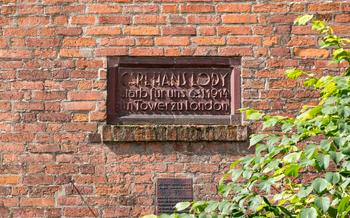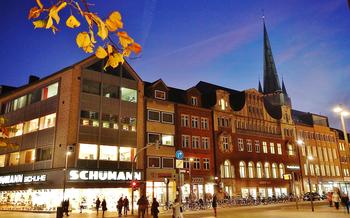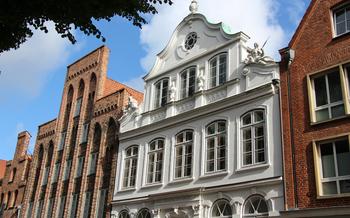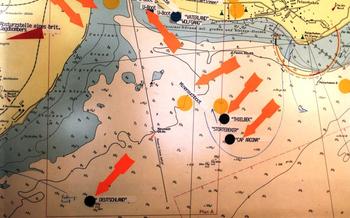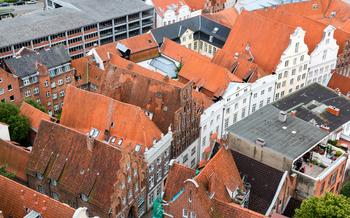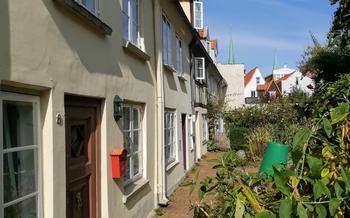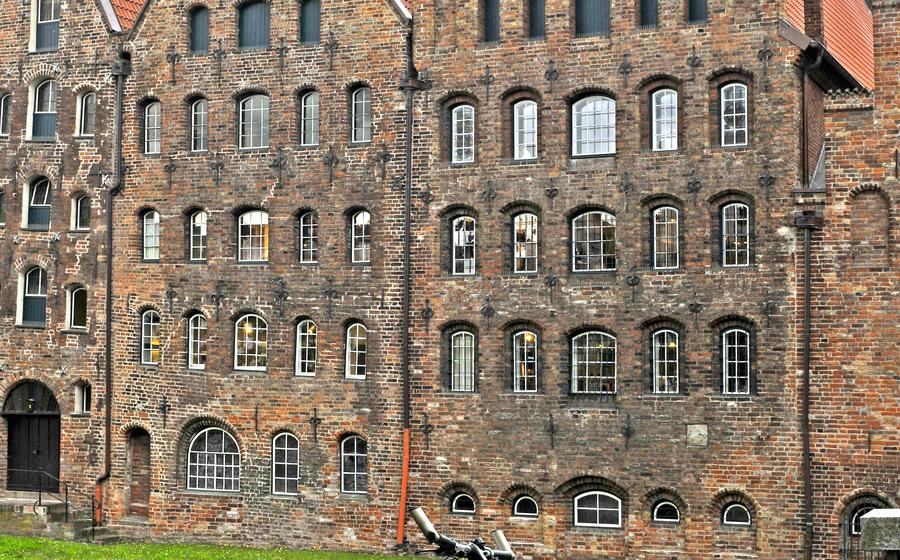
Salzspeicher (Salt Warehouses)
- The Salzspeicher: A Legacy of Maritime Trade
- Maritime Museum: A Journey Through Seafaring History
- European Hanseatic Museum: Exploring the Hanseatic League
- St. Mary's Church: A Gothic Masterpiece
- Holstentor: A Symbol of Lübeck's Fortifications
- Lübeck Cathedral: A Center of Spiritual Heritage
- Buddenbrookhaus: A Literary Landmark
- European Art Academy: A Hub of Artistic Excellence
- Willy-Brandt-Haus: Honoring a Statesman's Legacy
- Lübeck Town Hall: A Seat of Power and History
- St. Anne's Museum: A Treasury of Sacred Art
- Museum of Nature and the Environment: Exploring the Natural World
- Gunter Grass House: A Homage to a Literary Giant
- St. Peter's Church: A Haven of Peace and Tranquility
- Insider Tip: Off-the-Beaten-Path Gems
The Salzspeicher: A Legacy of Maritime Trade
The Salzspeicher, or salt warehouses, stand as a proud testament to Lübeck's rich maritime history. Built in the 16th century, these magnificent brick buildings once served as storage facilities for the vital commodity of salt, which was transported from distant lands to Lübeck, a major trading hub of the Hanseatic League. Their imposing facades, adorned with intricate gables and arched entrances, reflect the city's flourishing trade and prosperity during the Middle Ages.
The Salzspeicher's strategic location along the Trave River made it an ideal spot for loading and unloading goods. Salt, a highly valued commodity used for preserving food and other purposes, was meticulously stored within these warehouses, ensuring a steady supply to the city's population and beyond. The buildings' thick walls and sturdy construction protected the precious cargo from the elements and any potential threats, underscoring their vital role in Lübeck's economic success.
Maritime Museum: A Journey Through Seafaring History
Delve into the captivating world of seafaring at the Maritime Museum, a treasure trove of Lübeck's maritime heritage. Embark on an immersive journey through interactive displays and hands-on experiences that bring the city's seafaring past to life. Learn about famous seafarers and their daring voyages, and gain insights into the profound impact of maritime trade on Lübeck's prosperity.
Discover the stories of legendary sea captains who braved treacherous waters to forge new trade routes, connecting Lübeck to distant shores. Witness the evolution of shipbuilding techniques and marvel at the intricate craftsmanship of model ships that capture the essence of this maritime hub.
The Maritime Museum is not just a repository of historical artifacts; it's a dynamic space where visitors can engage with the past in a tangible way. Interactive exhibits allow you to steer a virtual ship, navigate through stormy seas, and experience the thrill of maritime exploration.
Through captivating tales of adventure and ingenuity, the Maritime Museum offers a profound appreciation for Lübeck's maritime legacy and its enduring influence on the city's identity and culture.
European Hanseatic Museum: Exploring the Hanseatic League
The European Hanseatic Museum in Lübeck is a fascinating journey through the history and significance of the Hanseatic League, a powerful trade alliance that dominated Northern Europe from the 13th to the 17th centuries.
-
The museum's interactive exhibits and multimedia presentations bring to life the Hanseatic League's impact on trade, culture, and politics, showcasing the cities, merchants, and ships that were part of this influential network.
-
Visitors can explore the replica of a Hanseatic cog ship, a symbol of the maritime prowess of the Hanseatic League, and learn about the daring voyages and trading expeditions undertaken by these seafaring merchants.
-
The museum also highlights the cultural and social impact of the league, shedding light on the exchange of ideas, knowledge, and goods that took place among the member cities, leaving a lasting legacy on the development of Northern Europe.
St. Mary's Church: A Gothic Masterpiece
St. Mary's Church, also known as the Marienkirche, is an iconic landmark in Lübeck and a shining example of Gothic architecture. Its construction began in the 13th century and was completed in the 15th century, reflecting the city's wealth and power during the Hanseatic League era.
The exterior of the church is adorned with intricate carvings, flying buttresses, and a soaring spire that dominates the city skyline. The interior is equally impressive, with a nave that stretches over 100 meters in length and features a stunning vaulted ceiling supported by slender pillars.
One of the most captivating features of St. Mary's Church is its collection of stained-glass windows, which are considered among the finest in Europe. These windows depict scenes from the Bible, the lives of saints, and historical events, casting a colorful glow on the interior space.
The church is also home to several significant artworks, including the Triumphal Cross, a large wooden crucifix carved around 1470, and the Totentanz, a series of paintings depicting the Dance of Death, a popular motif in medieval art.
St. Mary's Church is closely linked to Lübeck's maritime trade and the Salzspeicher. The church served as a spiritual center for the city's seafarers, who would pray for safe voyages and successful returns. In addition, the church's treasury was used to store valuable goods, such as spices and precious metals, brought back from distant lands.
Today, St. Mary's Church remains an active place of worship and a popular tourist attraction. Visitors can climb the tower for panoramic views of the city, admire the exquisite stained-glass windows, and learn about the church's rich history.
Holstentor: A Symbol of Lübeck's Fortifications
Historical significance and architectural features
The Holstentor, one of Lübeck's most iconic landmarks, stands as a testament to the city's rich history and architectural prowess. Constructed in the 15th century as part of the city's fortifications, this imposing gatehouse served as a crucial defense against invading forces. Its sturdy walls, adorned with intricate brickwork and decorative elements, reflect the Gothic architectural style prevalent at the time. The Holstentor's two massive towers, topped with copper-clad spires, create a striking silhouette against the backdrop of the city skyline.
Role in defending the city during sieges
Throughout its existence, the Holstentor played a pivotal role in safeguarding Lübeck from enemy attacks. During the Thirty Years' War, the city successfully resisted several sieges thanks to the strength of its fortifications, including the Holstentor. The gate's sturdy construction and strategic location at the entrance to the city made it a formidable obstacle for invading armies. Its towering presence instilled a sense of awe and intimidation in potential attackers, contributing to Lübeck's reputation as an impregnable fortress.
Symbol of Lübeck's resilience and strength
The Holstentor has become an enduring symbol of Lübeck's resilience and strength in the face of adversity. Its ability to withstand numerous sieges and remain largely intact speaks to the city's unwavering determination to protect its independence and sovereignty. Today, the Holstentor stands as a proud reminder of Lübeck's rich history and its enduring spirit. It is a beloved landmark that attracts visitors from around the world, who come to marvel at its architectural grandeur and learn about its significance in the city's past.
Lübeck Cathedral: A Center of Spiritual Heritage
Lübeck Cathedral, also known as the Cathedral of Our Lady, stands as a magnificent testament to the city's rich religious and cultural heritage. Its imposing Gothic architecture, dating back to the 12th century, captivates visitors with its intricate details and soaring spires. The cathedral's grand interior boasts an awe-inspiring collection of artworks, including exquisite stained-glass windows, elaborate ceiling frescoes, and intricately carved sculptures.
One of the cathedral's most striking features is its unique "Totentanz" or "Dance of Death" fresco, depicting a procession of figures from all walks of life, from popes and emperors to beggars and peasants, all dancing with skeletal figures representing death. This macabre masterpiece serves as a poignant reminder of the transience of human life and the inevitability of death.
The cathedral's connection to Lübeck's maritime history is evident in the numerous maritime symbols and motifs found throughout its interior. Intricate carvings of ships and sea creatures adorn the choir stalls, while the altar features a stunning depiction of the Virgin Mary as the "Star of the Sea," a symbol of protection and guidance for sailors.
Lübeck Cathedral remains an active place of worship, hosting regular services and events that bring the community together. Its spiritual significance and architectural grandeur make it a must-visit destination for anyone seeking to delve into the religious and cultural history of Lübeck.
Einblicke in die religiöse und kulturelle Bedeutung des Doms
Der Dom zu Lübeck ist nicht nur ein architektonisches Meisterwerk, sondern auch ein Ort von großer religiöser und kultureller Bedeutung. Als Zentrum des Bistums Lübeck war der Dom über Jahrhunderte hinweg der Sitz des Bischofs und spielte eine wichtige Rolle im kirchlichen Leben der Stadt. Auch heute noch finden hier regelmäßig Gottesdienste und andere religiöse Veranstaltungen statt.
Neben seiner religiösen Bedeutung ist der Dom auch ein wichtiger kultureller Ort. Er beherbergt eine umfangreiche Sammlung von Kunstwerken, darunter wertvolle Gemälde, Skulpturen und Glasfenster. Besonders sehenswert ist der Totentanz, ein Fresko aus dem Jahrhundert, das den Tanz des Todes mit Menschen aller Gesellschaftsschichten darstellt.
Der Dom ist auch ein beliebter Ort für Konzerte und andere kulturelle Veranstaltungen. Die gute Akustik des Doms macht ihn zu einem idealen Ort für Aufführungen von klassischer Musik, Jazz und Chormusik.
Buddenbrookhaus: A Literary Landmark
Nestled in the heart of Lübeck's historic Altstadt, the Buddenbrookhaus stands as a testament to the city's rich literary heritage. This stately 18th-century merchant house was once home to the Mann family, including Nobel Prize-winning author Thomas Mann. Today, it serves as a museum dedicated to their life and works.
The Buddenbrookhaus offers a fascinating glimpse into the world of the Mann family, who played a prominent role in Lübeck's cultural and intellectual circles. Visitors can explore the beautifully preserved rooms, which have been restored to their original splendor. Guided tours provide insights into the family's personal lives, their artistic influences, and the inspiration behind their literary masterpieces.
Special exhibitions and events are regularly held at the Buddenbrookhaus, allowing visitors to delve deeper into the works of Thomas Mann and his family. These exhibitions often showcase rare manuscripts, first editions, and personal artifacts, providing a unique perspective on their creative process and impact on German literature.
Whether you're a literary enthusiast or simply curious about Lübeck's cultural history, a visit to the Buddenbrookhaus is an immersive experience that offers a captivating journey into the lives and works of one of Germany's most celebrated literary families.
European Art Academy: A Hub of Artistic Excellence
In the heart of Lübeck's vibrant cultural scene, the European Art Academy stands as a beacon of artistic excellence. Founded in 1865, this renowned art school has nurtured generations of talented artists, contributing significantly to the city's rich artistic heritage. With a focus on fostering creativity and technical skills, the academy provides a comprehensive education in various artistic disciplines, including painting, sculpture, graphic design, and photography.
The academy's impressive facilities include spacious studios, well-equipped workshops, and a state-of-the-art gallery space. Renowned artists and experienced instructors guide students through a rigorous curriculum, encouraging them to push boundaries and explore their unique artistic voices.
Exhibitions showcasing student works and contemporary art regularly grace the academy's gallery, providing a platform for emerging artists to share their creations with the public. Workshops and classes are also offered to aspiring artists of all levels, creating a vibrant and inclusive artistic community.
A visit to the European Art Academy offers a glimpse into the creative energy that permeates Lübeck's cultural landscape. Whether you're an art enthusiast, a budding artist, or simply curious about the artistic process, this institution is sure to inspire and captivate.
Willy-Brandt-Haus: Honoring a Statesman's Legacy
Willy-Brandt-Haus, the birthplace and museum dedicated to former German Chancellor Willy Brandt, offers a fascinating glimpse into the life and impact of this remarkable statesman. Located in the heart of Lübeck, this historic building houses interactive exhibits, personal mementos, and multimedia displays that bring Brandt's political career and legacy to life.
Visitors can explore the various rooms of the museum, each dedicated to a different aspect of Brandt's life, from his early years and rise to power to his role in shaping Germany's foreign policy and his unwavering commitment to peace and international cooperation. Personal items, such as his Nobel Peace Prize medal and letters, offer a glimpse into the man behind the politician, while interactive exhibits allow visitors to engage with Brandt's ideas and policies.
The Willy-Brandt-Haus is not just a museum but also a center for political education and dialogue. It hosts regular events, lectures, and discussions on contemporary issues, inviting experts and the public to engage in meaningful conversations about the challenges and opportunities facing Germany and the world today.
Whether you're a history buff, a political enthusiast, or simply curious about the life of one of Germany's most influential leaders, a visit to the Willy-Brandt-Haus is a must. This museum offers a unique opportunity to learn about Brandt's vision for a more just and peaceful world and to be inspired by his unwavering commitment to democratic values.
Einblicke in das Leben und Wirken von Willy Brandt
Das Willy-Brandt-Haus bietet Einblicke in das Leben und Wirken von Willy Brandt, einem der bedeutendsten Politiker der deutschen Geschichte. Als Bundeskanzler prägte er die deutsche Außenpolitik maßgeblich und setzte sich für Frieden und internationale Verständigung ein. Das Museum zeigt persönliche Gegenstände, Briefe und Dokumente, die einen Eindruck von Brandts Persönlichkeit und seinen politischen Überzeugungen vermitteln.
Auch die Rolle Brandts in der internationalen Politik wird beleuchtet. Als Architekt der Ostpolitik trug er maßgeblich zur Entspannung zwischen Ost und West bei. Für seine Verdienste wurde er 1971 mit dem Friedensnobelpreis ausgezeichnet.
Das Willy-Brandt-Haus ist ein Ort der Erinnerung und des Dialogs. Es werden regelmäßig Veranstaltungen, Vorträge und Diskussionen zu aktuellen politischen Themen angeboten.
Lübeck Town Hall: A Seat of Power and History
Lübeck's Town Hall stands as a testament to the city's rich history and architectural prowess. This magnificent building, constructed in the 13th century, has served as the seat of the city's government for centuries, witnessing countless pivotal moments in Lübeck's development.
With its Gothic facade adorned with intricate carvings and sculptures, the Town Hall exudes an aura of grandeur and authority. Its towering spires and ornate gables blend seamlessly with the surrounding medieval architecture, creating a picturesque cityscape that transports visitors back in time.
Inside, the Town Hall boasts an equally impressive array of features. The grand entrance hall, with its vaulted ceilings and elaborate chandeliers, sets the tone for the opulent interiors that lie beyond. The Great Hall, where the city council once convened, is a masterpiece of Gothic architecture, featuring intricate wall paintings and a magnificent stained-glass window that depicts scenes from Lübeck's history.
Beyond the Great Hall, visitors can explore a labyrinth of corridors and chambers, each with its own unique story to tell. The Bürgermeisterzimmer, or Mayor's Office, is a testament to the power and prestige of Lübeck's leaders, with its opulent furnishings and stunning views overlooking the city.
The Town Hall's historical significance extends beyond its role as a seat of government. It has served as a venue for important events, such as the signing of the Treaty of Lübeck in 1629, which ended the Thirty Years' War. The building has also been a witness to the city's triumphs and tragedies, including the devastating air raids of World War II, which caused significant damage to its structure.
Today, Lübeck Town Hall stands as a symbol of the city's resilience and its commitment to preserving its rich heritage. It continues to serve as a functional government building, housing the offices of the mayor and city council, while also welcoming visitors who come to admire its architectural beauty and learn about its fascinating history.
St. Anne's Museum: A Treasury of Sacred Art
In the heart of Lübeck's historic Altstadt, nestled amidst the labyrinthine streets, lies the St. Anne's Museum, a sanctuary of sacred art and a testament to the city's rich religious heritage. Within the walls of this former church, now transformed into a museum, visitors are transported back in time to an era when art and faith were intricately intertwined.
The museum's collection is a treasure trove of medieval and Renaissance masterpieces, each piece a testament to the skill, devotion, and artistry of its creators. Exquisite altarpieces, intricately carved sculptures, and stunning paintings adorn the walls, telling stories of faith, hope, and redemption.
Among the highlights of the collection is the magnificent high altar, a masterpiece of late Gothic art. Its intricate carvings depict scenes from the life of Christ and the saints, while its vibrant colors and gilded details create a sense of awe and wonder.
The museum also houses a collection of medieval liturgical objects, including chalices, monstrances, and reliquaries, which provide a glimpse into the rituals and practices of the Catholic Church during the Middle Ages.
St. Anne's Museum is not just a repository of religious art; it is also a place of contemplation and reflection. Its serene atmosphere invites visitors to pause and appreciate the beauty and power of these sacred works, and to connect with the spiritual heritage of Lübeck.
Einblicke in die religiöse Kunst und die Bedeutung religiöser Kunstwerke
Das St. Annen-Museum bietet nicht nur eine Sammlung religiöser Kunst, sondern auch Einblicke in die Bedeutung religiöser Kunstwerke. Die ausgestellten Werke spiegeln die Glaubensvorstellungen und die Spiritualität der Menschen im Mittelalter und in der Renaissance wider. Sie zeigen, wie Kunst zur Vermittlung religiöser Botschaften eingesetzt wurde und wie sie zur Gestaltung von Gottesdiensten und Andachten beitrug.
Das Museum lädt die Besucher ein, sich mit der religiösen Kunst auseinanderzusetzen und ihre Bedeutung für die Kultur und Gesellschaft der damaligen Zeit zu verstehen. Es ist ein Ort, an dem man die Schönheit und die Kraft religiöser Kunstwerke erleben und sich mit dem spirituellen Erbe Lübecks verbinden kann.
Museum of Nature and the Environment: Exploring the Natural World
Lübeck's Museum of Nature and the Environment is an oasis of knowledge and wonder, inviting visitors to delve into the intricacies of the natural world.
Spread across two floors, the museum boasts a diverse array of exhibits that showcase the captivating flora and fauna of the region. Engaging displays on ecology and conservation further emphasize the importance of protecting our planet's precious ecosystems.
Interactive displays and hands-on activities make learning a fun and immersive experience, especially for young minds. Kids can explore the wonders of nature through interactive games, puzzles, and experiments that foster curiosity and understanding.
The museum also hosts temporary exhibitions that delve into specific environmental topics, offering visitors a deeper dive into the challenges and triumphs of conservation efforts. These exhibitions often feature thought-provoking artworks, scientific research, and interactive installations that spark dialogue and inspire action.
Whether you're a nature enthusiast, a conservation advocate, or simply seeking a fun and educational outing, the Museum of Nature and the Environment promises an enriching and enlightening experience for visitors of all ages.
Gunter Grass House: A Homage to a Literary Giant
In the heart of Lübeck's Altstadt, between the Holstentor and the Buddenbrookhaus, lies the Gunter Grass House, a museum dedicated to the life and works of Nobel Prize-winning author Günter Grass. This cultural gem offers visitors a unique opportunity to delve into the mind and imagination of one of Germany's most celebrated literary figures.
Through a series of interactive exhibits, multimedia presentations, and personal artifacts, the museum provides insights into Grass's writing process, his political activism, and his profound connection to his hometown of Lübeck. Visitors can trace the evolution of his literary career, from his early works to his later masterpieces, and explore the themes and ideas that shaped his writing.
Temporary exhibitions and cultural events further enrich the museum experience, showcasing Grass's lesser-known works, hosting readings and discussions, and inviting renowned authors and scholars to share their insights on his legacy. The Gunter Grass House is a must-visit for literature enthusiasts and anyone interested in the cultural and political history of Germany.
St. Peter's Church: A Haven of Peace and Tranquility
Amidst the vibrant streets of Lübeck, St. Peter's Church stands as an oasis of tranquility and spiritual reflection. Its history dates back to the 12th century, and its architectural features are a testament to the city's rich past. The church's exterior is adorned with intricate carvings and sculptures, while the interior boasts a stunning nave with vaulted ceilings and elegant pillars.
Visitors to St. Peter's Church are captivated by its serene atmosphere and the intricate details that adorn its interior. The church is home to several notable artworks, including a beautiful altarpiece depicting scenes from the life of Jesus Christ. The stained-glass windows, with their vibrant colors and intricate designs, cast a warm glow throughout the church, creating a truly awe-inspiring sight.
Beyond its architectural and artistic beauty, St. Peter's Church holds a significant place in the spiritual and cultural life of Lübeck. Throughout history, the church has served as a gathering place for the community, hosting religious services, concerts, and other cultural events. It remains an active parish church, offering a variety of services and programs for its members and visitors alike.
For those seeking a moment of peace and reflection, St. Peter's Church provides the perfect sanctuary. Its tranquil atmosphere and stunning beauty invite visitors to slow down, appreciate the finer things in life, and connect with their spiritual side. Whether you're a history buff, an art enthusiast, or simply someone in search of a quiet respite, St. Peter's Church is a must-visit destination in Lübeck.
Insider Tip: Off-the-Beaten-Path Gems
Beyond the main attractions, Lübeck offers a wealth of hidden treasures waiting to be discovered. Take a stroll through the picturesque courtyards and alleyways, where you'll find charming cafes, unique boutiques, and glimpses into the city's rich history. For art enthusiasts, seek out the smaller galleries and studios tucked away in unexpected corners, showcasing the works of local and up-and-coming artists. Indulge in the local culinary scene at one of the many hidden gem restaurants, serving traditional German dishes with a modern twist or international flavors that celebrate Lübeck's diverse cultural heritage. These off-the-beaten-path gems offer a unique perspective on the city, allowing you to experience Lübeck like a local and create lasting memories.
